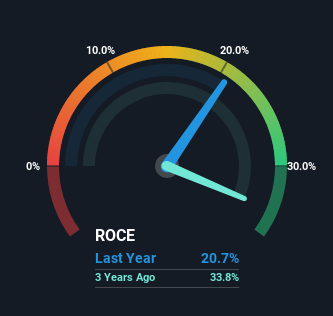- Hong Kong
- /
- Basic Materials
- /
- SEHK:691
China Shanshui Cement Group (HKG:691) Could Be Struggling To Allocate Capital
There are a few key trends to look for if we want to identify the next multi-bagger. Amongst other things, we'll want to see two things; firstly, a growing return on capital employed (ROCE) and secondly, an expansion in the company's amount of capital employed. If you see this, it typically means it's a company with a great business model and plenty of profitable reinvestment opportunities. So when we looked at China Shanshui Cement Group (HKG:691), they do have a high ROCE, but we weren't exactly elated from how returns are trending.
Return On Capital Employed (ROCE): What Is It?
Just to clarify if you're unsure, ROCE is a metric for evaluating how much pre-tax income (in percentage terms) a company earns on the capital invested in its business. To calculate this metric for China Shanshui Cement Group, this is the formula:
Return on Capital Employed = Earnings Before Interest and Tax (EBIT) ÷ (Total Assets - Current Liabilities)
0.21 = CN¥4.3b ÷ (CN¥31b - CN¥10b) (Based on the trailing twelve months to June 2022).
Therefore, China Shanshui Cement Group has an ROCE of 21%. In absolute terms that's a great return and it's even better than the Basic Materials industry average of 9.0%.
View our latest analysis for China Shanshui Cement Group

While the past is not representative of the future, it can be helpful to know how a company has performed historically, which is why we have this chart above. If you want to delve into the historical earnings, revenue and cash flow of China Shanshui Cement Group, check out these free graphs here.
So How Is China Shanshui Cement Group's ROCE Trending?
In terms of China Shanshui Cement Group's historical ROCE movements, the trend isn't fantastic. Historically returns on capital were even higher at 26%, but they have dropped over the last five years. On the other hand, the company has been employing more capital without a corresponding improvement in sales in the last year, which could suggest these investments are longer term plays. It may take some time before the company starts to see any change in earnings from these investments.
On a related note, China Shanshui Cement Group has decreased its current liabilities to 33% of total assets. Since the ratio used to be 84%, that's a significant reduction and it no doubt explains the drop in ROCE. Effectively this means their suppliers or short-term creditors are funding less of the business, which reduces some elements of risk. Some would claim this reduces the business' efficiency at generating ROCE since it is now funding more of the operations with its own money.
In Conclusion...
Bringing it all together, while we're somewhat encouraged by China Shanshui Cement Group's reinvestment in its own business, we're aware that returns are shrinking. And investors appear hesitant that the trends will pick up because the stock has fallen 30% in the last three years. On the whole, we aren't too inspired by the underlying trends and we think there may be better chances of finding a multi-bagger elsewhere.
China Shanshui Cement Group does have some risks though, and we've spotted 2 warning signs for China Shanshui Cement Group that you might be interested in.
China Shanshui Cement Group is not the only stock earning high returns. If you'd like to see more, check out our free list of companies earning high returns on equity with solid fundamentals.
New: AI Stock Screener & Alerts
Our new AI Stock Screener scans the market every day to uncover opportunities.
• Dividend Powerhouses (3%+ Yield)
• Undervalued Small Caps with Insider Buying
• High growth Tech and AI Companies
Or build your own from over 50 metrics.
Have feedback on this article? Concerned about the content? Get in touch with us directly. Alternatively, email editorial-team (at) simplywallst.com.
This article by Simply Wall St is general in nature. We provide commentary based on historical data and analyst forecasts only using an unbiased methodology and our articles are not intended to be financial advice. It does not constitute a recommendation to buy or sell any stock, and does not take account of your objectives, or your financial situation. We aim to bring you long-term focused analysis driven by fundamental data. Note that our analysis may not factor in the latest price-sensitive company announcements or qualitative material. Simply Wall St has no position in any stocks mentioned.
About SEHK:691
China Shanshui Cement Group
An investment holding company, engages in the manufacture and sale of cement, clinker, concrete, and related products and services in the People’s Republic of China.
Adequate balance sheet with very low risk.
Market Insights
Community Narratives




